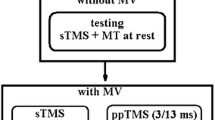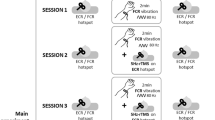Summary
The interaction of transcranial electric and magnetic brain stimulation with electrically elicited shortand long latency reflexes (LLR) of hand and fore-arm flexor muscles has been investigated in normal subjects. In the first paradigm, the motor potential evoked in thenar muscles by transcranial stimulation was conditioned by median nerve stimulation at various conditioning-test intervals. At short intervals (electric: 5–12.5 ms, magnetic: 0–7.5 ms) facilitation occurred that corresponded to the H-reflex and at longer intervals (electric: 25–40 ms, magnetic: 22.5–35 ms) there was a facilitation corresponding to the LLR. Electric and magnetic stimulation resulted in a similar degree of facilitation. A second paradigm investigated the facilitation of the forearm flexor H-reflex by a cutaneo-muscular LLR elicited by radial superficial nerve stimulation and transcranial stimulation used separately or together. When electric and magnetic brain stimulation were compared, magnetic brain stimulation was followed by significant extrafacilitation but electric stimulation was not. This result favours an interaction between the afferent volley eliciting the LLR and transcranial magnetic stimulation most likely at supraspinal level.
Similar content being viewed by others
References
Abbruzzese G, Berardelli A, Rothwell JC, Day LB, Marsden CD (1985) Cerebral potentials and electromyographic responses evoked by stretch of wrist muscles in man. Exp Brain Res 58544–551
Agnew WF, McCreery DB (1987) Considerations for safety in the use of extracranial stimulation for motor evoked potentials. Neurosurgery 20:143–147
Baldissera F, Hultborn H, Illert M (1981) Integration in spinal neuronal systems. In: Brookhart JM, Mountcastle VB, Brooks VB, Geiger SR (eds) Handbook of physiology: the nervous system II. Am Physiol Soc, Bethesda, pp 509–595
Barker AT, Freeston IL, Jalinous R, Merton PA, Morton HB (1985) Magnetic stimulation of the human brain. J Physiol (London) 369:9P
Benecke R, Meyer B-U, Göhmann M, Conrad B (1988) Analysis of muscle responses elicited by transcranial stimulation of the cortico-spinal system in man. Electroencephal Clin Neurophysiol 69:412–422
Berardelli A, Day BL, Marsden CD, Rothwell JC (1987) Evidence favouring presynaptic inhibition between antagonist muscle afferents in the human forearm. J Physiol 391:71–83
Caccia MR, McComas AJ, Upton ARM, Blogg T (1973) Cutaneous reflexes in small muscles of the hand. J Neurol Neurosurg Psychiat 36:960–977
Cheney PD, Fetz EE (1984) Corticomotoneuronal cells contribute to long-latency stretch reflexes in the rhesus monkey. J Physiol 349:249–272
Claus D, Mills KR, Murray NMF (1988a) The influence of vibration on the excitability of alpha motoneurones. Electroencephal Clin Neurophysiol 69:431–436
Claus D, Mills KR, Murray NMF (1988b) Facilitation of muscle responses to magnetic brain stimulation by mechanical stimuli in man. Exp Brain Res 71:273–278
Conrad B, Aschoff JC (1977) Effects of voluntary isometric and isotonic activity on late transcortical reflex components in normal subjects and hemiparetic patients. Electroencephal Clin Neurophysiol 42:107–116
Conrad B, Meyer-Lohmann J (1980) The long-loop transcortical load compensation reflex. TINS 3:269–272
Cowan JMA, Day BL, Marsden CD, Rothwell JC (1986) The effect of percutaneous cortex stimulation in muscles of the arm and leg in intact man. J Physiol 377:333–347
Creutzfeldt O (1983) Cortex cerebri. Springer, Berlin Heidelberg New York Tokyo
Day BL, Rothwell JC, Thompson PD, Dick JPR, Cowan JMA, Berardelli A, Marsden CD (1987a) Motor cortex stimulation in intact man. 2. Multiple descending volleys. Brain 110:1191–1209
Day BL, Thompson PD, Dick JP, Nakashima K, Marsden CD (1987b) Different sites of action of electrical and magnetic stimulation of the human brain. Neurosci Lett 75:101–106
Deletis V, Dimitrijevic MR, Sherwood AM (1987) Effects of electrically induced afferent input from limb nerves on the excitability of the human motor cortex. Neurosurgery 20:195–197
Deuschl G, Schenck E, Lücking CH (1985) Long-latency responses in human thenar muscles mediated by fast conducting muscle and cutaneous afferents. Neurosci Lett 55:361–366
Deuschl G, Michels R, Berardelli A, Schenck E, Inghilleri M, Lücking CH (1988a) On the interaction of transcranial and low threshold peripheral stimulation. In: Congr Internat Med Soc of Motor Disturb, Rom, Abstractbook P6
Deuschl G, Strahl K, Schenck E, Lücking CH (1988b) The diagnostic significance of long latency reflexes in multiple sclerosis. Electroencephal Clin Neurophysiol 70:56–61
Deuschl G, Ludolph A, Schenck E, Lücking CH (1989) The relation of long-latency reflexes in hand muscles, somatosensory evoked potentials and transcranial stimulation of motor tracts. Electroencephal Clin Neurophysiol 74:425–430
Fournier E, Meunier S, Pierrot-Deseilligny E, Shindo M (1986) Evidence for interneuronally mediated Ia excitatory effects to human quadriceps motoneurones. J Physiol (Lond) 377:143–169
Hess CW, Mills KR, Murray NMF (1987) Responses in small hand muscles from magnetic stimulation of the human brain. J Physiol 338:397–419
Inghilleri M, Berardelli A, Cruccu G, Priori A, Manfredi M (1989) Corticospinal potentials after transcranial stimulation in humans. J Neurol Neurosurg Psychiat 52:970–974
Jenner JR, Stephens JA (1982) Cutaneous reflex responses and their central nervous pathways studied in man. J Physiol 333:405–419
Malmgreen K, Pierrot-Deseilligny E (1988) Evidence for nonmonosynaptic Ia excitation of human wrist flexor motoneurones, possibly via propriospinal neurones. J Physiol (Lond) 405:747–764
Marsden CD, Merton PA, Morton HB (1973) Is the human stretch reflex cortical rather than spinal? Lancet 1:759–761
Marsden CD, Rothwell JC, Day BL (1983) Long-latency automatic responses to muscle stretch in man: origin and function. In: Desmedt JE (eds) Motor control mechanisms in health and disease. Raven Press, New York, pp 509–539
Meinck HM, Berkefeld J, Conrad B (1987) Kuntaneo-muskuläre Reflexe der menschlichen Han. II. Neurophysiologische Aspekte der Reflexorganisation und -Koordination. Z EEG-EMG 18:101–107
Merton PA, Morton HB (1980) Stimulation of the cerebral cortex in the intact human subject. Nature 285:227
Noth J, Podoll K, Friedemann KH (1985) Long-loop reflexes in small hand muscles studied in normal subjects and in patients with Huntington's disease. Brain 108:65–80
Rossini PM, Caramia M, Zarola F (1987a) Central motor tract propagation in man: studies with non-invasive, unifocal, scalp stimulation. Brain Res 415:211–225
Rossini PM, Gigli GL, Marciani MG, Zarola F, Caramia M (1987b) Noninvasive evaluation of input-output characteristics of sensorimotor cerebral areas in healthy humans. Electroencephal Clin Neurophysiol 68:88–100
Rothwell JC, Thompson PD, Day BL, Dick JPR, Kachi T, Cowan JMA, Marsden CD (1987) Motor cortex stimulation in intact man. 1. General characteristics of EMG responses in different muscles. Brain 110:1173–1190
Schieppati M (1987) The Hoffmann reflex: a means of assessing spinal reflex excitability and its descending control in man. Progr Neurobiol 28:345–376
Troni W, Cantello R, de Mattei M, Bergamini L (1988) Muscle responses elicited by cortical stimulation in the hand: differential conditioning by activation of the proprioceptive and exteroceptive fibers of the median nerve. In: Rossini PM, Marsden CD (eds) Non-invasive stimulation of brain and spinal cord fundamentals and clinical applications. A.L. Liss Inc, pp 73–83
Upton ARM, McComas AJ, Sicca REP (1971) Potentiation of “late” responses evoked in muscles during effort. J Neurol Neurosurg Psychiat 34:699–711
Verrier MC (1985) Alterations in H reflex magnitude by variations in baseline EMG excitability. Electroencephal Clin Neurophysiol 60:492–499
Author information
Authors and Affiliations
Rights and permissions
About this article
Cite this article
Deuschl, G., Michels, R., Berardelli, A. et al. Effects of electric and magnetic transcranial stimulation on long latency reflexes. Exp Brain Res 83, 403–410 (1991). https://doi.org/10.1007/BF00231165
Received:
Accepted:
Issue Date:
DOI: https://doi.org/10.1007/BF00231165




